The article provides information on the black garden ant, which can perform the role of a bionic prototype for designing durable working surfaces of cultivator rake tines. The toothed edge of the ant's mandible is considered a model area capable of executing various functions, including digging. The morphometric indicators of the toothed mandible edge in the studied ants have been examined. Some comments have been provided regarding the previously published work titled «Study of black garden ant mandibles as a bionic model to increase the reliability of cultivated paws». The conducted bionic research is founded on the principles of biomimicry.
Key words: bionics, agricultural mechanics, innovative solutions, ants, bionic model.
Приводятся сведения о черном садовом муравье, который может выступить в качестве бионического прототипа для проектирования износостойких рабочих поверхностей стрельчатых лап культиваторов. В качестве модельного участка у муравьев рассматриваются зубчатый край мандибул, которые выполняет различные функции, в том числе копательную. Рассмотрены некоторые морфометрические показатели зубчатого края мандибул исследуемых муравьев. Приведены комментарии к ранее опубликованной работе «Исследование мандибул черного садового муравья в качестве бионической модели для повышения надежности культиваторных лап». Проведенные бионические исследования построены на принципах биомимикрии.
Ключевые слова: бионика, земледельческая механика, инновационные решения, муравьи, бионическая модель.
In the modern world, a lot of attention is devoted to the development of bionic research to handle economically significant tasks [1]. The endless variety of approaches in nature can be used as a source of inspiration for innovative engineering solutions in agricultural mechanics [2]. To create a new progressive technology for manufacturing and strengthening the cultivator tines, it is advised to incorporate overhead elements in the soil cultivation tool's design. Guided by the bionic approach, the new elements aim to form specific relief on the friction surface, reducing the friction in the soil contact zone [3].
The efficiency of using specific organisms for designing the bionic prototype is determined by analyzing their functional purposes [2, 4]. The soil-dwelling insects from Coleoptera, Orthoptera, Neuroptera and Hymenoptera orders can serve as a model for the modified agricultural tool. Black garden ant ( Lasius niger (Linnaeus, 1758)) belonging to Hymenoptera order is a representative of these soil-dwelling organisms.
Materials and Methods. The research data was collected during the period from 2021 to 2023 at the Department of Zoology and UNESCO Chair in Science Education with Emphasis on Natural Sciences at the Belarusian State University. The soil-dwelling ants, L. niger , were considered as the bionic prototype.
The material was collected in the Belarusian urban cenoses. Insect collection was performed manually and in accordance with methodological recommendations for working with this taxon. Adult insects were preserved in 70 % ethanol in polypropylene tubes of various volumes and some of ants were also mounted on entomological pins, previously attached to paper triangular cards [6, 7]. All collected material was labeled.
The ants were studied using Optec SZ780T2L and MBS-9 stereomicroscopes. Species identification was conducted using specialized keys [7–9]. Dried insects were photographed using an Optec microscope with an attached Canon 1100d DSLR camera, and specific parts of the ant were meticulously studied using a LEO–1455 VP scanning electron microscope at the Belarusian Interuniversity Center for Scientific Research Equipment, part of the Physical Faculty at the Belarusian State University.
Measurements on the obtained images were made using the ImageJ software [10]. The measurement values are indicated from minimum to maximum, the arithmetic mean and standard error are included in parentheses. The construction of the bionic model was carried out in accordance with the relationship between the morphological parameters of the mandibles of the black garden ant and the working surfaces of the cultivator tines.
Results. The black garden ant is a common species in Belarus, which predominantly inhabits grassy habitats and can be found at forest edges, in parks, gardens, and also in urban areas. Nests are typically constructed in open, sun-exposed areas in the soil without any external structures. Colonies are frequently discovered under stones, branches, bricks, logs, and similar objects.
A large number of L. niger nests are observed in meadows and agrocenoses. The density of black garden ant nests in meadows can reach up to 2145 per hectare (or even 7–8 thousand nests per hectare in some cases), creating a distinct micro-relief. During nest construction, ants process about 26 m 3 of soil per hectare [10, 11]. The tunnels within the ant nest can reach depths exceeding 50 cm [12]. The ants use their mandibles, located on their heads (Figure 1, A; 1, B) for grasping and excavating.
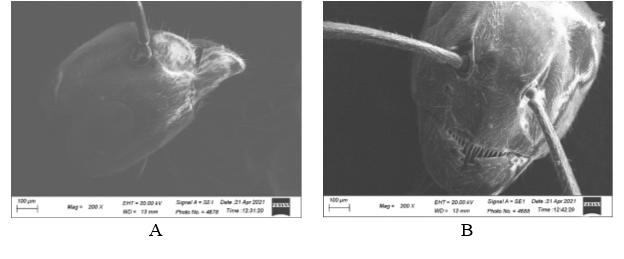
Fig. 1. Head of Lasius niger worker ant: A — lateral view; B — front view
The research on ant mandibles revealed the presence of 7–8 uneven teeth of a tetrahedral shape along the chewing edge (Figure 2, A). The teeth are not sharp but rather rounded towards the tip (Figure 2, B). Additionally, zinc ions were detected in the ant mandibles. The distribution of the ions was uneven, with a greater presence of the metal closer to the tips of the teeth.
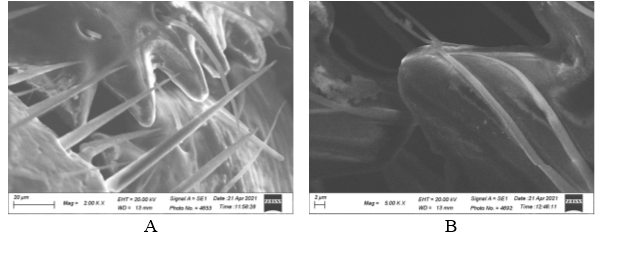
Fig. 2. Teeth on Lasius niger mandibles: A — general view; B — tooth
The length of the teeth ranges from 23.41 µm to 39.34 µm (with an average of 31.57±2.54 µm). No relief or texture is observed on the teeth. Sharpened and flattened parts are only found on the sides of the tetrahedron.
At the base of the teeth there are funnel-shaped, round, and oval openings equipped with hairs (Figures 2, A; 3, A; 3, B). These funnel-shaped openings have diameters ranging from 6.69 µm to 11.11 µm (with an average of 8.87±0.71 µm). Additionally, on the remaining surface of the mandible, there are openings with diameters ranging from 6.33 µm to 10.43 µm (with an average of 8.05±0.50 µm) (Figures 3, A; 3, B).
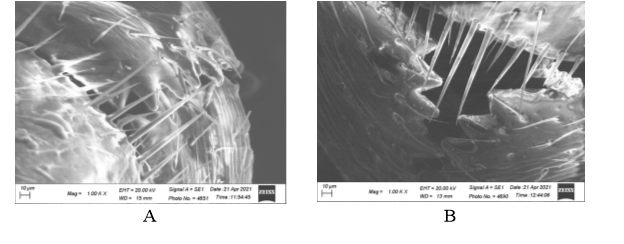
Fig. 3. Lasius niger mandubles: А — view from clypeus side; B — parted mandibles, front view
Apart from the openings, the mandible surface exhibits a relief structure, containing numerous winding grooves (Figures 3, A, B; 4 A, B).
The relief (sculptural) structure of the mandible, along with the presence of openings, likely reduces friction with the substrate and diminishes the pression on the chitinous skeleton. This assumption is based on the direct contact of the investigated surfaces with the soil.
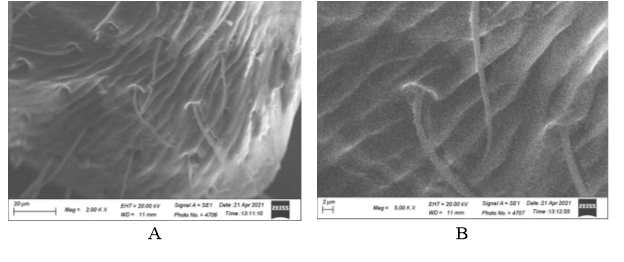
Fig. 4. Lateral view of Lasius niger mandibles at high magnification
An interesting feature is observed in the structure of the lower edge of the mandible (Figures 5 A, B). There is an indentation and a significant number of funnel-shaped pits with hairs arranged in two rows in a checkerboard pattern. It is hypothesized that these formations on the lower edge of the mandible reduce the primary pressure on the organ during tasks, protecting the mandibles against overheating and overloading.
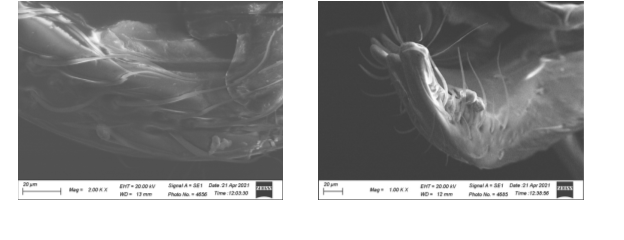
Fig. 5. Microstructure of the lower side of the Lasius niger mandibula
The material presented in the article «Study of black garden ant mandibules as a bionic model to increase the reliability of cultivated paws» [5] contain an inaccuracy in figure labeling: figure 1 — Camponotus sp. imago. The concept of bionic modeling is established through the principles of biomimicry, focusing on functions and areas subjected to the most significant stress.
According to our assumption, issues with durability of cultivator tines could be solved by applying the morphology of the toothed edge of the ant mandibles. The following models for strengthening and structuring of cultivator tines are suggested:
– Equip the cutting edge with small teeth resembling those on the mandibles of the black garden ant, applying tetrahedral-shaped teeth with rounded tips.
– Create shallow relief on the surface of the rake tine behind the cutting edge, resembling grooves on the superficial layer, with sufficiently funnel-shaped openings in the center, equipped with fixed metal «balls» (resembling hairs found in the natural analog).
– In the rear section of the rake tine, create small funnel-shaped openings with a «ball» at the center.
Тaking into account that the primary load during various tasks is experienced by the mandible teeth, the toothed edge is considered a potential bionic prototype for designing wear-resistant working surfaces of rake tines in cultivators. This modification might involve the development of a fundamentally new organ that closely mimics the natural one. This approach encompasses biomimicry ideas, involving the study of natural systems and processes to create new materials, structures, and technologies.
Acknowledgments. The research was conducted as part of the research project “Investigation of wear-resistant bioinspired working surfaces of cultivator rake tines for vegetable crop care” at the State Scientific research program “Agricultural Technologies and Food Security”. We express our gratitude to the Interuniversity Center for Scientific Research Equipment, part of the Physical Faculty at Belarusian State University, and specifically to the lead engineer of the radiation and vacuum equipment maintenance sector, Dr. S. V. Gusakova, for their assistance in conducting research using electron microscopy methods.
References:
1. Chizhov A. A. Bionika kak neobhodimyj novyj vektor razvitija [Bionics as the new required vector of development] // Interactive science. — 2020. — № 9. — P. 8–16. DOI: 10.21661/r-552948. (in Russian).
2. Azarenko V. V., Goldyban V. V., Behun P. P. Metodicheskie podhody peredachi reshenij ot biologii k inzhenerii [Methodological approaches of decision transfer from biology to engineering] // Mechanization and Electrification of Agriculture. — 2023. — Iss. 56. — P. 3–8. (in Russian).
3. Tkachenko G. A., Sinchuk A. V., Goldyban V. V., Kovalchuk A. V. Povyshenie nadezhnosti kul'tivatornyh lap za schet uprochnenija rabochih poverhnostej na osnove bionicheskogo podhoda [Increasing the reliability of cultivator shares by strengthening the working surfaces based on the bionic approach] // Modern technologies for procurement production [Electronic resource]: collection of scientific works of the Republican Scientific and Technical Conference of faculty, researchers, doctoral students and PhD students of Faculty of Mechanics and Technology Belarusian National Technical University, April 14, 2021; ed. A. P. Bezhok. — Minsk: BNTU, 2021. — P. 149–151 (in Russian).
4. Dyachenko V. A., Smirnov A. B. Bionicheskie osnovy dizajn-proektirovanija: uchebnoe posobie [Bionic fundamentals of design: educational materials]. — St. Petersburg: Publishing House of the Polytechnic University, 2008. — 195 p. (in Russian).
5. Goldyban V. V., Sinchuk A. V., Tkachenko G. A., Kurylovich M. I. Issledovanie mandibul chernogo sadovogo murav'ja v kachestve bionicheskoj modeli dlja povyshenija nadezhnosti kul'tivatornyh lap [Study of black garden ant mandibules as a bionic model to increase the reliability of cultivated paws] // Mechanization and Electrification of Agriculture. — 2022. — Iss. 55. — P. 251–258. (in Russian).
6. Golub V. B., Tsurikov M. N., Prokin A. A. Kollekcii nasekomyh: sbor, obrabotka i hranenie materiala [Collections of insects: collection, processing and storage of material]. — Moscow: KMK Scientific Press Ltd., 2012. — 339 p. (in Russian).
7. Sinchuk A. V. Opredelitel' murav'ev (Hymenoptera: Formicidae) Belarusi: uchebnye materialy [Key to ants (Hymenoptera: Formicidae) of Belarus: educational materials]. — Minsk: Belarusian State University, 2015. — 50 p. (in Russian).
8. Radchenko A. G. Murav'i (Hymenoptera, Formicidae) Ukrainy [The ants (Hymenoptera, Formicidae) of Ukraine]. — Kyiv: I. I. Schmalhausen Institute of Zoology of National Academy of Sciences of Ukraine, 2016. — 480 p. (in Russian).
9. Lebas C., Galkowski C., Blatrix R., Wegnez P. Fourmis d’Europe occidentale [The ants from Western Europe]. — Paris: Delachaux et Niestlé, 2016. — 415 p. (in French).
10. Abdrakhimova Y. R., Abdrakhimov F. A. Bioimidzhing kletok: vvedenie v analiz izobrazhenij s pomoshh'ju ImageJ. Chast' 1: uchebno-metodicheskoe posobie [Cell Bioimaging: An Introduction to Image Analysis with ImageJ. Part 1: educational and methodological manual]. — Kazan: Al'jans, 2019. — 25 p. (in Russian).
11. Zryanin V. A. Vlijanie murav'ev roda Lasius na pochvy lugovyh biogeocenozov [The influence of ants of the genus Lasius on the soils of meadow biogeocenoses] // Advances in Current Biology. — 2003. — Vol. 123, n. 3. — P. 278–287. (in Russian).
12. Novoselov A. L. Biologicheskaja aktivnost' muraveiynikov Lasius niger L. [Biological activity of anthills Lasius niger L.] abstract of theses... PhD biology: 03.02.08; M. V. Lomonosov Moscow State University. — Moscow, 2010. — 26 p. (in Russian).
13. Sinchuk A. V. Nekotorye aspekty jekologii chernogo murav'ja Lasius niger L. [Some aspects of the ecology of the black garden ant Lasius niger L.] // Itogi polevogo sezona — 2010: materials of the 1st regional scientific zoological conference dedicated to the international year of biodiversity, Brest, December 11, 2010; ed.: A. N. Tarasyuk [et al.]. — Brest: Al'ternativa, 2011. — P. 58–61. (in Russian).







